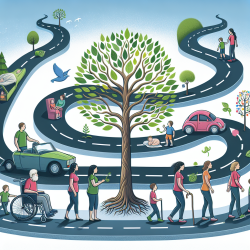Introduction
In the realm of pediatric rehabilitation, particularly for children with cerebral palsy (CP), adherence to home exercise programs (HEPs) remains a significant challenge. Low adherence rates, often ranging from 34% to 67%, can severely limit the potential effectiveness of these programs. A recent study, "Evaluating the impact of movement tracking feedback on engagement with home exercise programmes of children with cerebral palsy using a new therapy app," offers promising insights into how technology can enhance engagement and outcomes for these children.
Understanding the Study
This study employed a mixed-methods single-case experimental design to assess the impact of movement tracking feedback on engagement with a therapy app called Bootle Boot Camp (BBCamp). Sixteen children with CP, aged 6-12 years, participated in the study, where they used the app to complete individualized HEPs. The app was tested in two modes: with and without movement tracking feedback.
The primary outcome measured was adherence, defined as the proportion of prescribed exercise repetitions attempted. Secondary outcomes included affective and cognitive engagement, exercise fidelity, and participant experiences.
Key Findings
- Increased Adherence: The study found that movement tracking feedback significantly improved adherence rates. Children were more likely to complete their prescribed exercises when they received real-time feedback on their performance.
- Enhanced Engagement: Feedback not only improved behavioral engagement but also positively influenced affective and cognitive engagement. Children reported higher enjoyment and perceived the exercises as more beneficial when feedback was provided.
- Improved Exercise Fidelity: Movement tracking feedback helped reinforce optimal movement performance, leading to better exercise fidelity.
Implications for Practitioners
For practitioners working with children with CP, these findings highlight the potential of integrating movement tracking feedback into therapy apps to enhance engagement and outcomes. Here are some practical steps practitioners can take:
- Incorporate Feedback Mechanisms: Utilize apps that provide real-time feedback to help children understand and improve their movement quality.
- Customize Therapy Plans: Leverage technology to tailor HEPs to the individual needs and abilities of each child, enhancing motivation and adherence.
- Monitor and Adjust: Regularly assess the effectiveness of the therapy app and make adjustments based on data-driven insights to optimize outcomes.
Encouraging Further Research
While this study provides valuable insights, further research is needed to explore the long-term effects of movement tracking feedback on therapy adherence and outcomes. Practitioners are encouraged to participate in or initiate research studies that examine different aspects of technology integration in pediatric rehabilitation.
To read the original research paper, please follow this link: Evaluating the impact of movement tracking feedback on engagement with home exercise programmes of children with cerebral palsy using a new therapy app: a protocol for a mixed-methods single-case experimental design with alternating treatments.










